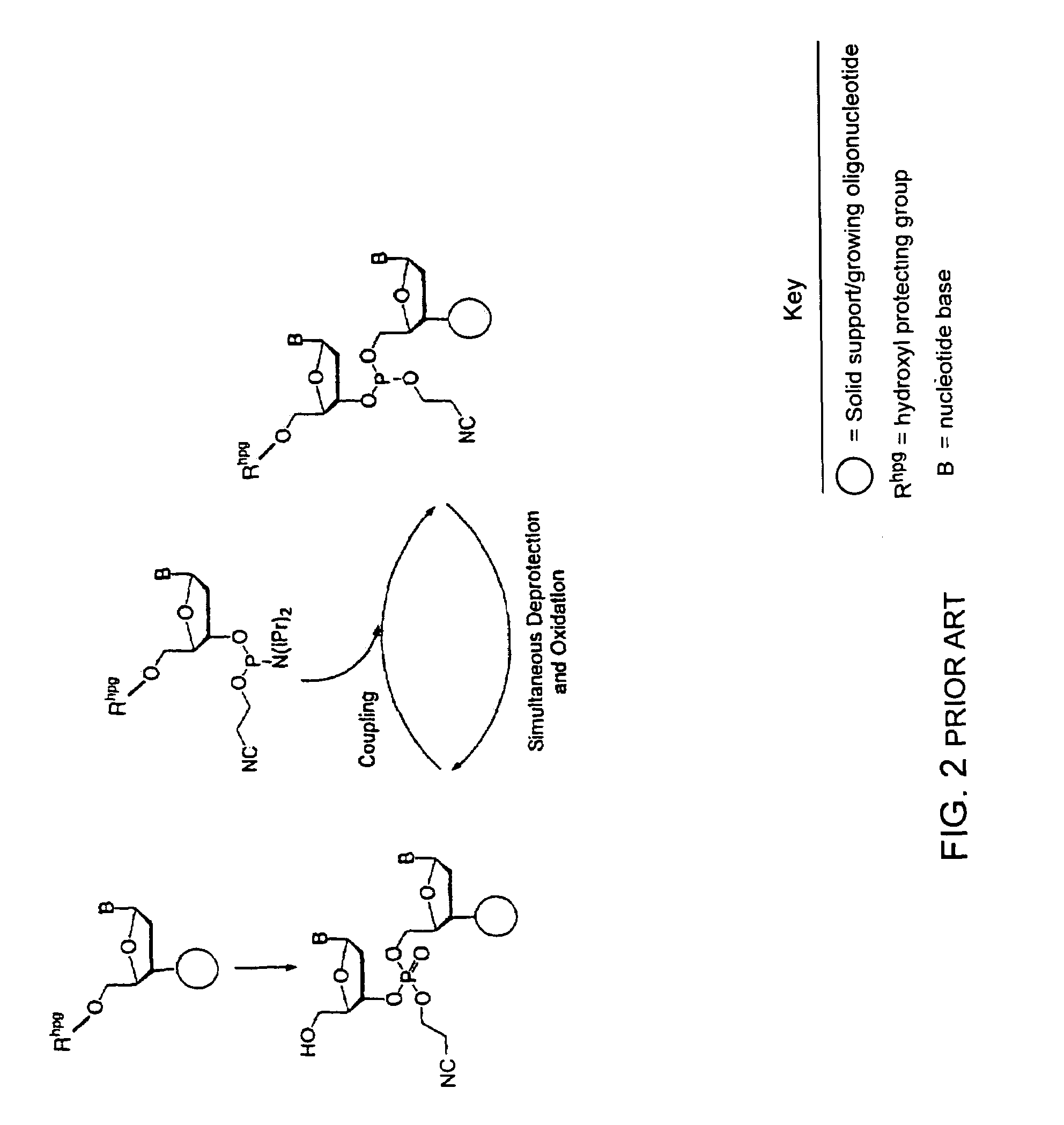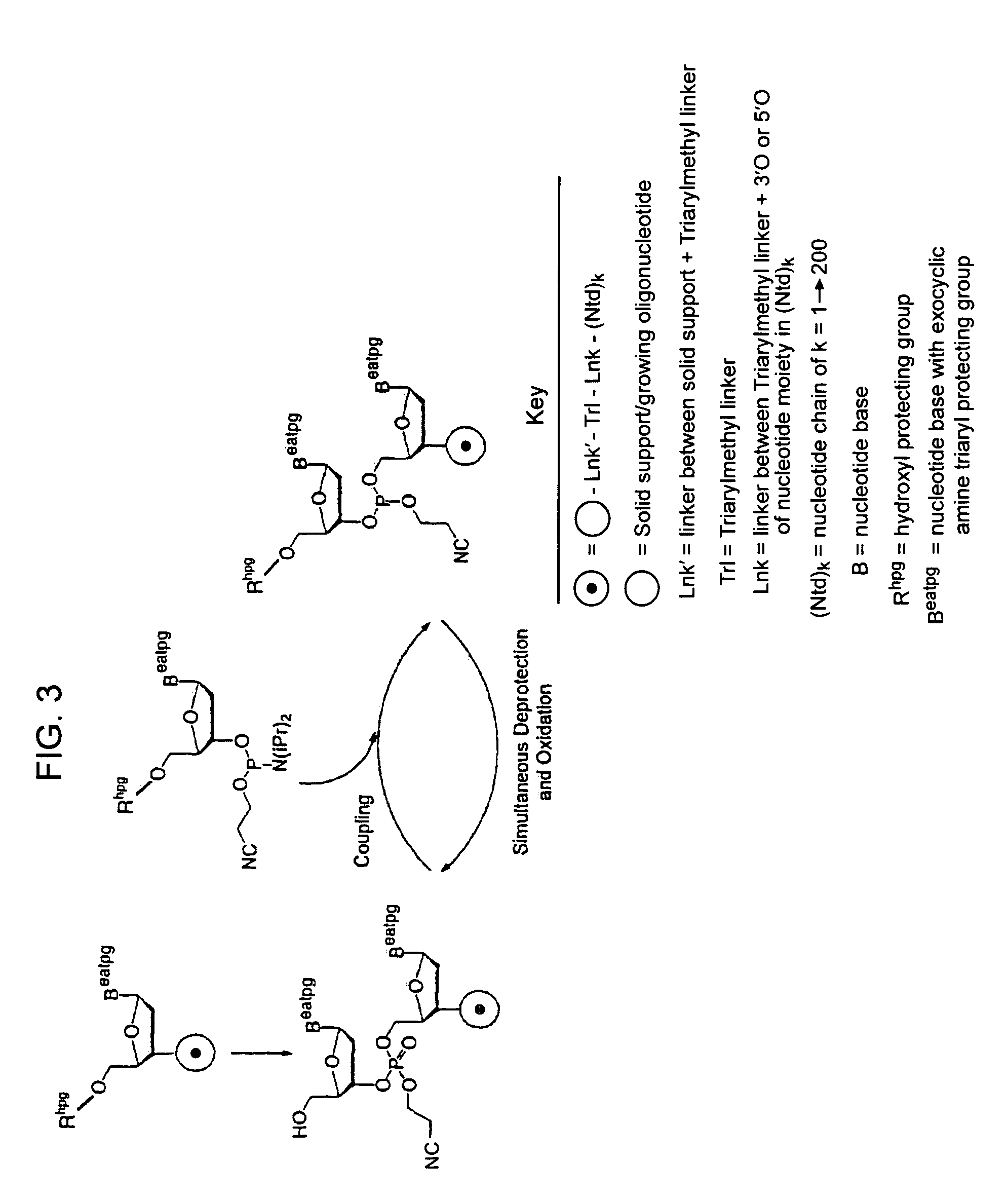Method for polynucleotide synthesis
a polynucleotide and synthesis technology, applied in the field of polynucleotide synthesis, can solve the problems of exacerbated problems associated with the use of dmt, reduced yield of final oligonucleotides, and limited success in approaches
- Summary
- Abstract
- Description
- Claims
- Application Information
AI Technical Summary
Benefits of technology
Problems solved by technology
Method used
Image
Examples
examples
[0174]The practice of the present invention will employ, unless otherwise indicated, conventional techniques of synthetic organic chemistry, biochemistry, molecular biology, and the like, which are within the skill of the art. Such techniques are explained fully in the literature.
[0175]The following examples are put forth so as to provide those of ordinary skill in the art with a complete disclosure and description of how to perform the methods and use the compositions disclosed and claimed herein. Efforts have been made to ensure accuracy with respect to numbers (e.g., amounts, temperature, etc.) but some errors and deviations should be accounted for. Unless indicated otherwise, parts are parts by weight, percents are wt. / wt., temperature is in ° C. and pressure is at or near atmospheric. Standard temperature and pressure are defined as 20° C. and 1 atmosphere.
[0176]A synthesis of reagents used in certain embodiments of the present invention is now described. It will be readily app...
example a
5′-O-(4-(3-(4-Nitrophenoxycarbonyl)-aminopropoxy)-4′-methoxytrityl)-2′-deoxythymidine is produced by the following protocol
4-HYDROXY-4′-METHOXYTRITYL ALCOHOL
STEP 1
[0178][0179]A. 25.0 g (126.2 mmoles) 4-hydroxy Benzophenone (1); Aldrich # H2020-2[0180]B. 500 ml THF; Aldrich # 49446-1[0181]C. 700 ml of a 0.5 M Solution in THF (175 mmoles) 4-Anisyl Magnesium Bromide; Alpha-Aesar # 89435
[0182]TLC System: HEX / EtOAc / Acetone (4:1:1)+0.5% Et3N on silica gel.
[0183]Using a 3-L 3-neck round bottom flask with a mechanical stirrer, U-tube thermometer and drying tube, (A) was added to (B) and the solution was cooled to 4° C. in a dry-ice / acetone bath, under Argon atmosphere. (C) was added drop wise over a period of 1 hour. Precipitate forms tan→pink color. The temperature was kept between 0-5° C. during the addition. The mixture was removed from the bath and stirred at ambient temperature (under Argon atmosphere) for 16-hours. The solvent was evaporated in vacuo. The residue was suspended in 300 ...
example b
4-Hydroxy-4′-Methoxytrityl Alcohol
Step 1
[0223][0224]A. 25.0 g (126.2 mmoles) 4-hydroxy Benzophenone (1); Aldrich # H2020-2[0225]B. 500 ml THF; Aldrich # 49446-1[0226]C. 700 ml of a 0.5 M Solution in THF (175 mmoles) 4-Anisyl Magnesium Bromide; Alpha-Aesar # 89435
[0227]TLC System: HEX / EtOAc / Acetone (4:1:1)+0.5% Et3N on silica gel
[0228]Using a 3-L 3-neck round bottom flask with a mechanical stirrer, U-tube thermometer and drying tube, (A) was added to (B) and the solution was cooled to 4° C. in a dry-ice / acetone bath, under Argon atmosphere. (C) was added drop wise over a period of 1 hour. Precipitate forms tan→pink color. The temperature was kept between 0-5° C. during the addition. The mixture was removed from the bath and stirred at ambient temperature (under Argon atmosphere) for 16-hours. The solvent was evaporated in vacuo. The residue was suspended in 300 ml ether and 200 mL cold water. The ether layer was extracted with 150 mL saturated NaHCO3 and 150 mL saturated NaCl and dri...
PUM
| Property | Measurement | Unit |
|---|---|---|
| pH | aaaaa | aaaaa |
| pressure | aaaaa | aaaaa |
| temperature | aaaaa | aaaaa |
Abstract
Description
Claims
Application Information
 Login to View More
Login to View More - R&D
- Intellectual Property
- Life Sciences
- Materials
- Tech Scout
- Unparalleled Data Quality
- Higher Quality Content
- 60% Fewer Hallucinations
Browse by: Latest US Patents, China's latest patents, Technical Efficacy Thesaurus, Application Domain, Technology Topic, Popular Technical Reports.
© 2025 PatSnap. All rights reserved.Legal|Privacy policy|Modern Slavery Act Transparency Statement|Sitemap|About US| Contact US: help@patsnap.com



